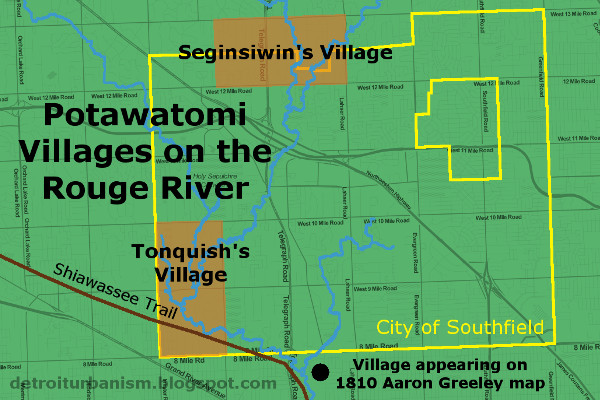Figure 23. Potawatomi Villages on the River Rouge Ceded in the 1827 Treaty of St. Joseph. Reprinted from “Detroit Urbanism: Indian Villages, Reservations, and Removal,” by P. Sewick, 2016 (http://detroiturbanism.blogspot.com/2016/03/indian-villages-reservations-and-removal.html).
As part of the Treaty of St. Joseph, signed September 19th, 1827, the Potawatomi ceded to the U.S. Government settlements along the River Rouge and River Raisin in southeast Michigan and areas in southwest Michigan around the Kalamazoo River (Printed Copy of the Ratified Treaty Between the United States and the Potawatomi Indians Signed at St. Joseph, Michigan Territory, on September 19, 1827, 1829).
The second paragraph in this new treaty cited the need to “consolidate some of the dispersed bands of the Potawatamie Tribe in the Territory of Michigan” and listed several tracts of land that were previously reserved for the Potawatomi, which they were to cede to the United States (Printed Copy of the Ratified Treaty Between the United States and the Potawatomi Indians Signed at St. Joseph, Michigan Territory, on September 19, 1827, 1829). Consequently, in addition to ceding four of the five 1821 reservations, the Huron Potawatomi also ceded most of the 1807 reservations, except for a one-half section of land on the River Raisin where Chief Pierre Moran resided.
The St. Joseph Treaty clearly stated the Potawatomi were to cede these lands to keep them “as far as practicable from the settlements of the Whites” as well as the territorial road leading from Detroit to Chicago (Printed Copy of the Ratified Treaty Between the United States and the Potawatomi Indians Signed at St. Joseph, Michigan Territory, on September 19, 1827, 1829, p. 1).
The 1827 Treaty also enlarged the Nottawaseppi Reservation to a “continuous reservation” of “ninety-nine sections,” where a “section” is an area nominally one square mile (Printed Copy of the Ratified Treaty Between the United States and the Potawatomi Indians Signed at St. Joseph, Michigan Territory, on September 19, 1827, 1829). One thousand five hundred people inhabited the reservation at that time, which was an excellent expanse of wilderness containing “fine, deep-soiled prairies, exceptional timber, and the navigable waters of the St. Joseph River” (Rodwan & Anewishki, 2009, p. 6).
References:
Printed Copy of the Ratified Treaty Between the United States and the Potawatomi Indians Signed at St. Joseph, Michigan Territory, on September 19, 1827 (Indian Treaties, 1789-1869). (1829). U.S. Government; General Records of the United States Government, Record Group 11. https://digitreaties.org/treaties/treaty/102278399/
Rodwan, John, and Virginia Anewishki. Nottawaseppi Huron Band of the Potawatomi, A People in Progress. Pine Creek Reservation, 2009.
Sewick, P. (2016, March 7). Detroit Urbanism: Indian Villages, Reservations, and Removal. Detroit Urbanism. http://detroiturbanism.blogspot.com/2016/03/indian-villages-reservations-and-removal.html

